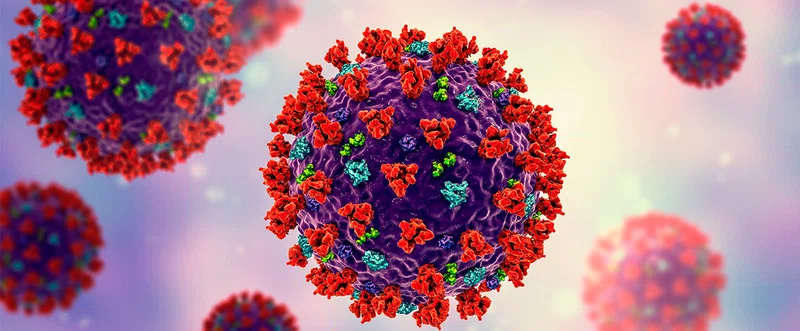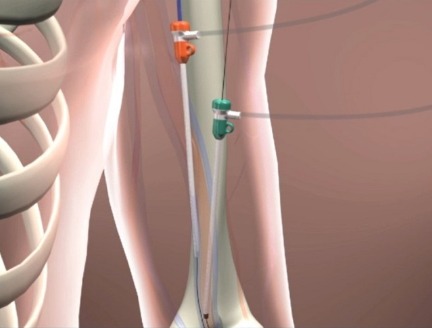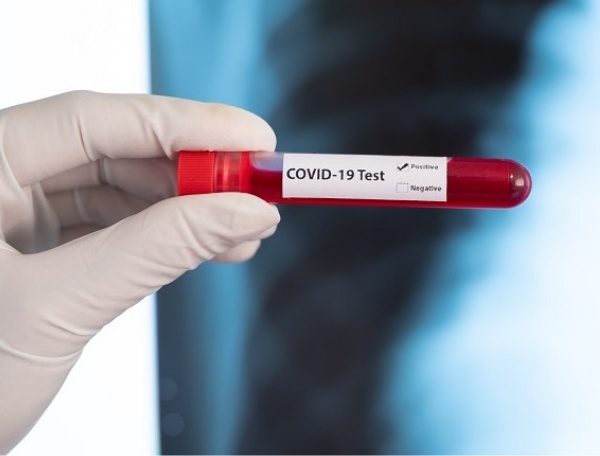


Clinical Research
Poly ADP Ribose Polymerase 9 (PARP9): a potential therapeutic target for controlling RNA viral diseases, including SARS-CoV-2

Illustration of coronavirus particles
Poly ADP Ribose polymerases (PARPs) are a functionally promiscuous class of enzymes that play significant roles in myriad cellular processes. They add ADP Ribose modifications onto acceptor proteins playing a vital role in chromatin regulation, transcription, RNA biology, DNA repair, genomic stability, programmed cell death, stress response, metabolism, anti-viral responses and cancer. This gamut of functional roles led Zhiqiang Zhang, PhD, associate professor at the Houston Methodist Transplant Immunology in Surgery, to investigate the PARP family for possible roles in host innate immunity.
Zhang conducted an extensive set of experiments, some of which used knock-out models to clearly identify and characterize one member, PARP9 (one of 17 PARP family members), as a noncanonical sensor that recognizes RNA viral infections and plays an important role in protective immunity.
RNA viruses are a leading cause of human infectious diseases and are a significant burden on public health and the global economy. Rabies, dengue, measles, influenza, Zika, human immunodeficiency virus and, notably, the recently emerged severe acute respiratory syndrome (SARS) COVID-19 virus are all RNA viruses. Pathogenic RNA viruses are a challenge for global disease control, making knowledge of the molecular mechanisms of underlying RNA viral infections and host antiviral immunity of utmost importance for creating improved treatment strategies.
There are several mechanisms used by the immune system that provide frontline defense against viral infections, including pattern recognition receptors that detect RNA viruses by recognizing anomalous viral nucleic acids. Pathogen sensing activates signaling pathways that trigger specific gene expression to eliminate viral pathogens. However, how viral nucleic acids physically bond upon recognition is unclear.

Zhiqiang Zhang, PhD
One major category of RNA sensors involved in detecting RNA viruses are retinoic acid-inducible gene 1-like receptors that act via the mitochondrial antiviral signaling (MAVS) pathway and induce Type I interferons (IFN). This signaling cascade is the classical pathway of host immune defense against viral infections.
Zhang and his research team generated PARP9 knock-outs and then generated PARP9 and MAVS double knock-out models. These models, together with RNA knockdown, overexpression studies, coimmunoprecipitation and RNA-sequencing analyses led to the discovery that PARP9 detects RNA viruses and acts independently of MAVS, signaling IFN production. IFNs ultimately block viral replication and thereby control viral pathogenesis. Based on these results, Zhang designated PARP9 as a noncanonical RNA virus sensor, especially since most RNA sensors act via the MAVS pathway to trigger IFN production.
Specifically, PARP9 was found to bind double-stranded viral RNA in the region of 1,100-1,400 base pairs in reovirus (an RNA virus). Microarray gene expression analysis indicated an extremely low PARP9 expression in most cell types. Yet, PARP9 was notably induced by IFNα as well as the influenza A RNA virus in human dendritic cells. PARP9 induction by IFNs pinpointed a critical, positive feed-forward loop. Indeed, PARP9 knock-out murine models were markedly susceptible to RNA viral infections – as a result of deficient IFN production in vivo.
The 2019 coronavirus outbreak in Wuhan, China, serves as a reminder that the new emerging RNA viruses remain a significant public health threat. Our findings on PARP9 may provide an opportunity for better interventions in boosting protective antiviral immunity through PARP9 induction with chemical compound. Our findings may also be beneficial in the design of better pharmacological agonists to improve the efficacy of RNA virus vaccines and prophylactics.”

Zhiqiang Zhang
PhD, Associate professor
Houston Methodist Transplant Immunology in Surgery
Zhang studied downstream adaptors of PARP9 post-RNA virus infection and proposed a working model of the PARP9 cascade. According to this model, PARP9 recruits and activates phosphatidylinositol 3-kinase and Ak strain transforming 3 pathways that activate IRF3 and IRF7 via phosphorylation – leading to the induction of type I IFN production and antiviral immune responses. PARP9 was found to be essential for type I IFN production and plays a crucial role in the host defense mechanism against RNA virus infections both in vivo and in vitro.
In his research study published in Nature Communications, Zhang shared another noteworthy finding related to macro domains. Macro domain proteins, characterized by the presence of ancient, evolutionarily conserved macro domains, play important roles in various biological processes ranging from DNA repair, chromatin remodeling and transcriptional regulation. The involvement of macro domains in infectious diseases was not described before this study. Macro domains are present as part of various proteins in all forms of life from yeast to humans and, interestingly, in RNA viruses. Experiments conducted by Zhang revealed a novel role of the PARP9 macro domains in binding double-stranded RNA of RNA viruses.
Many viruses and microbial parasites exploit macro domain proteins for host cell infection and viral replication. For instance, the macro domain-containing non-structural protein (NSP3) is necessary for replication of the mosquito-borne sindbis virus that is endemic in Northern Europe. They are also present in many other RNA viruses including viruses for hepatitis E, Chikungunya, Venezuelan equine encephalitis, and SARS-CoV-2. It is plausible that several viruses, including SARS-CoV-2, employ their macro domain-containing NSP3s to preclude double-stranded RNA recognition by PARP9 thereby halting type 1 IFN production. Taken together, these findings highlight macro domains as a potential future therapeutic target.
“The 2019 coronavirus outbreak in Wuhan, China, serves as a reminder that the new emerging RNA viruses remain a significant public health threat. Our findings on PARP9 may provide an opportunity for better interventions in boosting protective antiviral immunity through PARP9 induction with chemical compound. Our findings may also be beneficial in the design of better pharmacological agonists to improve the efficacy of RNA virus vaccines and prophylactics,” said Zhang.
The global catastrophe caused by the COVID-19 RNA virus underscores the importance of discovering how viruses modify immune responses. RNA viruses are a challenge for modern medicine because of their adaptive capabilities, diversity, short generation times and rapid evolutionary rates. Zhang’s research efforts have pinpointed a clinically significant target and a potential for improved pharmacological strategies, and further study is warranted.
Junji Xing, Ao Zhang, Yong Du, Mingli Fang, Laurie J Minze , Yong-Jun Liu, Xian Chang Li, Zhiqiang Zhang. Identification of poly(ADP-ribose) polymerase 9 (PARP9) as a noncanonical sensor for RNA virus in dendritic cells. Nat Commun 2021. May 11;12(1):2681. doi: 10.1038/s41467-021-23003-4.
Z.Z. is supported by Lupus Research Alliance grant 519418 and National Institutes of Health grant R56AI148215. X.C.L. is supported by the National Institutes of Health grant R01AI080779. J.X. is supported by the American Heart Association Career Development Award 20CDA35260116 (Xing). A.Z. is supported by the National Postdoctoral Program for Innovative Talents (BX20200399).
Abanti Chattopadhyay, PhD, August 2021








